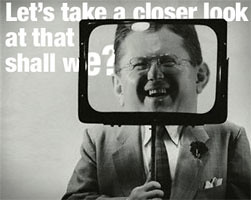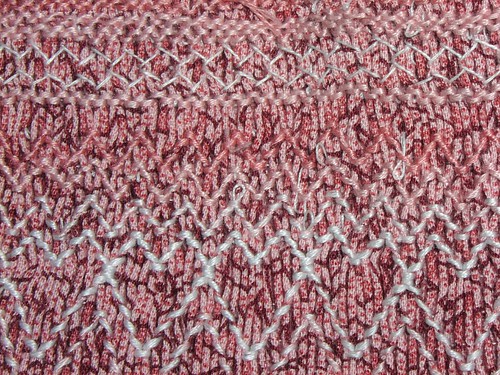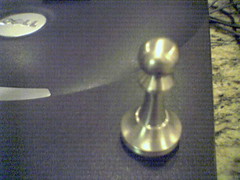Friday, April 29, 2005
Thursday, April 28, 2005
Friday, April 22, 2005
Searching Audio Content of Podcasts
So a question that many of you have probably been asking yourselves is "Gee, how do I really search the audio content of podcasts for stuff I might be interested in?"
Well, give this a try.
http://www.podscope.com/
Well, give this a try.
http://www.podscope.com/
Wednesday, April 20, 2005
The Misery of Reading Page One
Greg Little of Ad Astra magazine wrote the article linked above in the title of this post earlier today. I read it with that familiar sense of shared pain. Here is my response to the article.
Many of my comrades, co-workers, friends and relatives, as well as plenty of innocent bystanders, have been exposed to my cranky diatribes about how marginalized science reporting continues to be and how undervalued the true heroes of our economy, culture, and society currently are.
It's not just science reporting, either. It's a cultural snottiness about intellectualism.
I'm not really talking about the quasi-celebrated stuff like Apollo 13. A book, a movie, and a couple of awards are great. Increasing awareness of what we can and have accomplished is wonderful.
However, stepping out of Hollywood and away from one particular mission of one particular agency of one particular government, the true scope of actual and potential scientific activity should, if you have any sort of perception, dwarf that rocket ride and awe you into speechlessness.
The waste of time, treasure, and talent on silly crap is just plain criminal, especially since so much is spent on so little, and so little is spent on so much.
The constant droning whine of consumerism can seem deafening.
A world equally awash in pure scientific research isn't any fun, nor is it realistic. A healthy balance between mindless entertainment and awareness of the universe is what's necessary for the advancement of civilization.
When being a good citizen really means you're a good consumer, when citizens are only considered consumers, when material consumption is the only thing measured within society, then that society has ceased functioning as anything other than an economic machine. Reductionism never works. In the end, diversity, independence, and expression are what makes communities work.
So what to do?
Expect people to know what you are talking about when you talk about basic, fundamental, easy-to-appreciate science. Reject the sarcastic snotty remarks about how it's all over their heads. That is horse crap. It's one thing for someone to follow a discussion about high-energy accelerator research in Japan. It's quite another for someone to claim ignorance when you're talking about basic research, experiment, or exploration, when they are fully capable of understanding it.
If we act ashamed of our interest in science, then that sends the wrong message. Being unapologetic-yet-approachable, enthusiastic and undaunted, and concentrating hard on excellent communications skills is the only way to represent the invaluable importance of learning how our world works.
When a stupid article or story keeps clogging up the airwaves, creating its own press, then write a letter, express your opinion, and make sure that other people know where you stand. Refuse to be part of the gossip chain of low-quality news. Refuse to volulntarily fund it, refuse to consume it, refuse to let it pollute the surroundings you control.
If this sounds like censorship, then let me explain why it isn't. Censorship is when you examine and then purge the expressions of yourself or of others. Freedom of speech - the ability to express the thoughts of the individual - is absolutely vital. It's a basic right that should not be abridged.
However, no one requires you to continue to voluntarily expose yourself to low-quality communications disguised as news. Give some feedback, ask for changes, and move on. We are not big dumb cows that have no choice. We are individuals that deserve to be treated much better than big dumb cows.
Another danger is assuming that everyone else except for you and your geek clique is a big dumb cow, that placidly and passively accepts whatever is being currently plastered all over prime time news - Michael Jackson Trial, Robert Blake Trial, who's on Fear Factor... whatever.
This isn't really true. It's a conspiracy of contempt - contempt for other people - that might actually be just as dissatisfied as you are with the low quality of the news and the lack of real meaning in cultural correspondence. They may have different interests, styles, or levels of achievement. However, not every soccer mom is a vapid, mindless, handbag-buying effigy of the cult of the dollar. Not every middle-aged bank teller is a simpleton. Not every roofer is a dangerou, drug-addicted menace, preying on women in bars. Every single person can and should be motivated to support the advancement of our civilization. If this means a bit of discomfort and learning, then too bad! It's a small price to pay in the endless struggle to understand.
Many of my comrades, co-workers, friends and relatives, as well as plenty of innocent bystanders, have been exposed to my cranky diatribes about how marginalized science reporting continues to be and how undervalued the true heroes of our economy, culture, and society currently are.
It's not just science reporting, either. It's a cultural snottiness about intellectualism.
I'm not really talking about the quasi-celebrated stuff like Apollo 13. A book, a movie, and a couple of awards are great. Increasing awareness of what we can and have accomplished is wonderful.
However, stepping out of Hollywood and away from one particular mission of one particular agency of one particular government, the true scope of actual and potential scientific activity should, if you have any sort of perception, dwarf that rocket ride and awe you into speechlessness.
The waste of time, treasure, and talent on silly crap is just plain criminal, especially since so much is spent on so little, and so little is spent on so much.
The constant droning whine of consumerism can seem deafening.
A world equally awash in pure scientific research isn't any fun, nor is it realistic. A healthy balance between mindless entertainment and awareness of the universe is what's necessary for the advancement of civilization.
When being a good citizen really means you're a good consumer, when citizens are only considered consumers, when material consumption is the only thing measured within society, then that society has ceased functioning as anything other than an economic machine. Reductionism never works. In the end, diversity, independence, and expression are what makes communities work.
So what to do?
Expect people to know what you are talking about when you talk about basic, fundamental, easy-to-appreciate science. Reject the sarcastic snotty remarks about how it's all over their heads. That is horse crap. It's one thing for someone to follow a discussion about high-energy accelerator research in Japan. It's quite another for someone to claim ignorance when you're talking about basic research, experiment, or exploration, when they are fully capable of understanding it.
If we act ashamed of our interest in science, then that sends the wrong message. Being unapologetic-yet-approachable, enthusiastic and undaunted, and concentrating hard on excellent communications skills is the only way to represent the invaluable importance of learning how our world works.
When a stupid article or story keeps clogging up the airwaves, creating its own press, then write a letter, express your opinion, and make sure that other people know where you stand. Refuse to be part of the gossip chain of low-quality news. Refuse to volulntarily fund it, refuse to consume it, refuse to let it pollute the surroundings you control.
If this sounds like censorship, then let me explain why it isn't. Censorship is when you examine and then purge the expressions of yourself or of others. Freedom of speech - the ability to express the thoughts of the individual - is absolutely vital. It's a basic right that should not be abridged.
However, no one requires you to continue to voluntarily expose yourself to low-quality communications disguised as news. Give some feedback, ask for changes, and move on. We are not big dumb cows that have no choice. We are individuals that deserve to be treated much better than big dumb cows.
Another danger is assuming that everyone else except for you and your geek clique is a big dumb cow, that placidly and passively accepts whatever is being currently plastered all over prime time news - Michael Jackson Trial, Robert Blake Trial, who's on Fear Factor... whatever.
This isn't really true. It's a conspiracy of contempt - contempt for other people - that might actually be just as dissatisfied as you are with the low quality of the news and the lack of real meaning in cultural correspondence. They may have different interests, styles, or levels of achievement. However, not every soccer mom is a vapid, mindless, handbag-buying effigy of the cult of the dollar. Not every middle-aged bank teller is a simpleton. Not every roofer is a dangerou, drug-addicted menace, preying on women in bars. Every single person can and should be motivated to support the advancement of our civilization. If this means a bit of discomfort and learning, then too bad! It's a small price to pay in the endless struggle to understand.
Tuesday, April 19, 2005
Engineer's Hair Cut (long hair version)
Long hair? Check. Engineer? Check. Want free hair cut? Check. Want it to look ok or good? Check. Want it to last no longer than 30 seconds and involve no travel? Check. Want to still be able to braid hair? Check. Have a sharp pair of scissors, the full use of your arms, and have the ability to bend at the waist? Check.
You are ready for the female engineer hair cut (long hair version).
Protocol:
Get sharp pair of scissors.
Brush hair.
Flip hair over head, bending at waist.
Brush hair to straighten it out.
Hold hair with non-dominant hand at arm's length straight out from face. Angle with major axis of head should be close to 90 degrees.
What you will see:

What other people will see, standing off to the side:

If necessary, use hair tie to capture and hold hair in preparation for cutting.
Snip!
Discard.
Brush.
End result front and back:


Shorten distance from nose to gathering point to shorten cut.
Advantages: layering achieved, quick, easy, free.
Disadvantages: bangs are another separate protocol.
Simple Bangs Protocol: Gather hair from temples to crown of head. Pull hair together with hair tie or fingers. Form 45 degree angle from the horizontal plane of head. Measure several inches.
Snip! Snip!
Blunt bangs created in one cut. Repeat if shorter bangs are desired. Start long, go shorter gradually.
You are ready for the female engineer hair cut (long hair version).
Protocol:
Get sharp pair of scissors.
Brush hair.
Flip hair over head, bending at waist.
Brush hair to straighten it out.
Hold hair with non-dominant hand at arm's length straight out from face. Angle with major axis of head should be close to 90 degrees.
What you will see:

What other people will see, standing off to the side:

If necessary, use hair tie to capture and hold hair in preparation for cutting.
Snip!
Discard.
Brush.
End result front and back:


Shorten distance from nose to gathering point to shorten cut.
Advantages: layering achieved, quick, easy, free.
Disadvantages: bangs are another separate protocol.
Simple Bangs Protocol: Gather hair from temples to crown of head. Pull hair together with hair tie or fingers. Form 45 degree angle from the horizontal plane of head. Measure several inches.
Snip! Snip!
Blunt bangs created in one cut. Repeat if shorter bangs are desired. Start long, go shorter gradually.
Sunday, April 17, 2005
Banana Split
Michael digging in to his first banana split sundae at Farrell's in San Diego. Michael played "King of the Road" and "Tijuana Taxi" on the player piano. He had a wonderful outing.
Tricycle Fight
Thursday, April 14, 2005
Verizon Ads in Mobile Photo Blogging Update
Original Post:
http://w5nyv.blogspot.com/2005/04/unwanted-ads-from-verizon-in-mobile.html
Update? The update is that there is no update. No one got back to me upon the second email! Gosh, I'm so surprised...
http://w5nyv.blogspot.com/2005/04/unwanted-ads-from-verizon-in-mobile.html
Update? The update is that there is no update. No one got back to me upon the second email! Gosh, I'm so surprised...
Essay on Dysfunctional Work Situations
I've had three really interesting conversations this week with three different people in three different job situations. All three conversations have contributed to the forceful crystallization of heretofore latent belief.
If you are in a job, and you are not treated courteously, professionally, and given opportunities to grow in your career, then you Must Leave. Yes. Leave. Walk out. Now.
"Ah, but that's not reasonable. What about my friends/bills/family/future/routine/fear/status?"
All of that crap will still be there. If finances are an issue, then envision, budget, plan, execute, and review. It's not rocket science. It's a better life. If you transition now, then a year later, you'll be in a new situation. If you wait, in a year you'll be a year older in your old situation.
You'd think, after 10,000 years of evolution, that we'd be past dysfunctional workplaces. We're not. They're all over the place. And, to be perfectly clear, I'm not talking about workplaces that aren't to someone's taste. There's no explaining one person's taste for working in retail when compared against another person's distaste of working in R&D. It may take a couple of jobs to figure out that you're working in the wrong place or field or part of the country. Or, you're simply working with or for the wrong person.
Situations that are great with one or two exceptions are manageable. Situations where you are literally the only functional, caring, productive employee are not manageable. They are dysfunctional. A single person has very little opportunity to change a snotty, sloppy, unpleasant organizational culture. The balance between what a person can and cannot control is narrow. There are so many different types of jobs out there that staying trapped in a dysfunctional one, regardless of pay, is a truly unsupportable choice.
When I say regardless of pay, I really mean it. A large salary or a big raise will keep someone in a crappy job for a bit longer. But, they will still leave. In fact, people leave highly-paid-but-miserable-jobs in droves. Some people leave after a few weeks of misery. Other people hang on for months, or rarely, years. Still others stay because they like being a victim and enjoy complaining about their miserable job, yet won't do a damn thing about it because that would involve effort. This victimology is corrosive to society.
There are at least two ways to go about changing things. One, sheer force of work ethic. It's the blue-collar, up-by-the-bootstraps, seniority wins in the end approach. It used to work a lot more often than it does now. Company loyalty, in many cases, carried the day.
The second approach is to take evasive action through education, certification, and other verifiable, objectively-determined successes. If you need a certification to get the job you want, then you get the certification. It's almost a no-brainer. The decision matrix becomes 1) the time/value of the goal job going forward 2) the time/value spent getting the credential 3) the cost of staying in the current job going forward.
If you want to work as an astronomer, and you don't have an advanced degree in physics or astronomy or chemistry or any of the other applicable degrees, then guess what? You're going to have to go to school. Either that, or make a series of significant contributions to science and use those as your credential.
If you want to be a garbage truck driver, and you aren't a member of the union, then guess what? You need to find out what it takes to join!
If you are in a job, and you are not treated courteously, professionally, and given opportunities to grow in your career, then you Must Leave. Yes. Leave. Walk out. Now.
"Ah, but that's not reasonable. What about my friends/bills/family/future/routine/fear/status?"
All of that crap will still be there. If finances are an issue, then envision, budget, plan, execute, and review. It's not rocket science. It's a better life. If you transition now, then a year later, you'll be in a new situation. If you wait, in a year you'll be a year older in your old situation.
You'd think, after 10,000 years of evolution, that we'd be past dysfunctional workplaces. We're not. They're all over the place. And, to be perfectly clear, I'm not talking about workplaces that aren't to someone's taste. There's no explaining one person's taste for working in retail when compared against another person's distaste of working in R&D. It may take a couple of jobs to figure out that you're working in the wrong place or field or part of the country. Or, you're simply working with or for the wrong person.
Situations that are great with one or two exceptions are manageable. Situations where you are literally the only functional, caring, productive employee are not manageable. They are dysfunctional. A single person has very little opportunity to change a snotty, sloppy, unpleasant organizational culture. The balance between what a person can and cannot control is narrow. There are so many different types of jobs out there that staying trapped in a dysfunctional one, regardless of pay, is a truly unsupportable choice.
When I say regardless of pay, I really mean it. A large salary or a big raise will keep someone in a crappy job for a bit longer. But, they will still leave. In fact, people leave highly-paid-but-miserable-jobs in droves. Some people leave after a few weeks of misery. Other people hang on for months, or rarely, years. Still others stay because they like being a victim and enjoy complaining about their miserable job, yet won't do a damn thing about it because that would involve effort. This victimology is corrosive to society.
There are at least two ways to go about changing things. One, sheer force of work ethic. It's the blue-collar, up-by-the-bootstraps, seniority wins in the end approach. It used to work a lot more often than it does now. Company loyalty, in many cases, carried the day.
The second approach is to take evasive action through education, certification, and other verifiable, objectively-determined successes. If you need a certification to get the job you want, then you get the certification. It's almost a no-brainer. The decision matrix becomes 1) the time/value of the goal job going forward 2) the time/value spent getting the credential 3) the cost of staying in the current job going forward.
If you want to work as an astronomer, and you don't have an advanced degree in physics or astronomy or chemistry or any of the other applicable degrees, then guess what? You're going to have to go to school. Either that, or make a series of significant contributions to science and use those as your credential.
If you want to be a garbage truck driver, and you aren't a member of the union, then guess what? You need to find out what it takes to join!
Article about Convergence
Reprinted without permission from NYT. (article below my comments)
I disagree with the premise that wiring a home (even an older one) for ethernet is "very expensive". That just isn't true. The reason I say it isn't true is that if you are able to spend the money on all the other toys (DVD, TV, PC, MP3, broadband, Etc) then the cost of wiring up all the rooms with ethernet outlets is in line with the benefit of connectivity.
Ethernet is superior to using home electical wiring, but proper use of home electrical wiring can enable connectivity, up to a point. HomePlug isn't the same as BPL (aka Poisonous Spectrum Pollution) and provides decent coverage. The coax group is interesting, but the point about splitters causing asymmetry is valid.
In answer to this article, I'd say forget the fancy cobbled-together stuff for powerline and coax, and do the right thing and go ethernet cable. You won't get clobbered by weird interference. You won't cause interference. The connections can be put virtually anywhere, and speeds are more than sufficient. You don't give up a bunch of AC outlets. You won't have a bunch of wall-warts on the wall.
The article doesn't address the other very interesting things besides regular old entertainment that can be realized with a truly convergent home. Things like bar-code scanners for your trash so you can generate a replacement shopping list that can be sent directly to the grocery store for delivery... stuff like that. But, those sorts of convergent ideas will only be fully realized once a critical mass of people get past the first-order entertainment thinking and spread their wings.
Even with entertainment you can get pretty sophisticated. Tivo or whatever DVR you have can do amazing things once connected to a LAN.
It really is a pre-golden era for entertainment and household function. It will be far better, less obtrusive (or intrusive) than the "Jetsons vision" and will seem like a natural progression from the way most people have set up their houses now. That's my take on it!
*********
April 14, 2005
Everything's Connected, Yes. But How?
By ERIC A. TAUB
Consumer technology seers say they think they have a good idea about the home of the future. It will be a place where photos, television shows, movies and music will be stored centrally and available in any room on demand.
It is called the connected home, where television sets, digital video recorders, DVD and music players and computers are all tied together. But an important question must be answered before the connected home becomes a reality: how will everything actually be connected?
A number of electronics companies and industry groups are working to answer that question, developing standards for connecting home entertainment devices.
Consumers who have created a small home computer network know of a few solutions that at first glance seem like candidates, like Ethernet cables and wireless.
But while tying together two or three computers to share an Internet connection and swap the occasional music or photo file is one thing, a home entertainment network can be another thing entirely. It can involve many more gadgets: television sets in the family room, kitchen and bedrooms; cable boxes; satellite TV receivers; DVD and audio players in the den; amplifiers and speakers scattered throughout the house; and one or more computers. And multimedia files like high-definition video or movies can be enormous, requiring lots of bandwidth.
Running Ethernet wire throughout a house to connect so many devices can be very expensive, particularly in an older home. And current versions of home wireless technology are not good contenders for home entertainment. Signals can be erratic, depending on the time of day, distance from the router and factors like interference from other home appliances. Move a wireless television like Sony's LocationFree model around the house, and watch the picture come and go.
So the ideal solution for the connected home would seem to be to find some wiring already in the house that digital data could share. Fortunately, most homes already have electrical wiring and coaxial cable.
Baby boomers may recall that a home's electrical wiring has been called into alternative service previously. In the 1970's, various companies sold devices with such names as the Little Wonder TV Antenna. Plug it into the wall, and it promised to turn a home's wiring into "a giant TV antenna," forever ridding the set of ghosts and snow.
Unlike those novelty items, today's radically different technology actually works. Companies like NetGear already sell products that extend wireless signals by transmitting them through electrical wiring to other rooms. To pick up the signal, users plug a network interface box into an electrical outlet.
The technology uses a standard called HomePlug 1.0, developed by an industry group called the HomePlug Powerline Alliance. The group hopes an advanced version of that standard, HomePlug AV, will become an industry standard for home-entertainment networks.
Backed by companies like Comcast, EchoStar and RadioShack, the group is designing its HomePlug AV standard to reliably carry 150 megabits of data a second over home electrical wiring. A high-definition video stream uses about 24 megabits a second, so the standard should provide enough capacity to simultaneously send multiple streams of HD video from room to room.
Not everyone thinks the HomePlug approach is such a great idea. Another group of semiconductor and electronics companies, including D-Link, Motorola, Panasonic and Thomson, wants to use existing coaxial cable, now used for cable TV, as the network link. Many homes already have coax going to at least several rooms.
Last week, the Multimedia Over Coax Alliance announced that it had successfully tested the technology in more than 200 homes, and that it was able to deliver data at a rate of 100 megabits a second in 95 percent of the wall outlets it tested.
The 5 percent that did not achieve that rate have problems like deteriorated cable and "are easily fixable," said Ladd Wardani, president of the group. "In the worst case, we'd just have to run another coax cable," he said. But if that happened with power lines, "you'd need an electrician to fix it."
Mr. Wardani also argued that coax cables were not subject to line interference from other devices, as the technology operates in a different frequency range.
HomePlug proponents naturally disagree with such conclusions. Various error-correcting technologies eliminate problems like noise, according to Oleg Logvinov, president of the group.
Mr. Logvinov said that the coaxial cable approach had problems. Because many consumers use cable TV splitters, coax will not be easily suitable for two-way communications, he said.
"The fundamental issue is, what is the convenience factor?" Mr. Logvinov said. "Where I would place my L.C.D. TV is not necessarily where I would have a coax outlet."
Consumer electronics companies continue to hedge their bets, supporting either multiple connectivity approaches or none at all.
Panasonic, a former member of the HomePlug Alliance, has left the group; together with Sony and Mitsubishi it has created the CE-Powerline Communications Alliance, which advocates another version of power line technology. HomePlug's specification does not adequately address interference issues, according to Paul Liao, Panasonic North America's chief technology officer.
Yet at the same time, Panasonic is also working with the coaxial cable group. Its partners Sony and Mitsubishi continue as members of HomePlug.
And Sharp, while also a member of the HomePlug Alliance, "is in no way committed to one technology or organization," said Deepak Ayyagari, principal scientist with Sharp Laboratories.
No matter how ubiquitous coax or electrical outlets may be in a house, there will always be some place in a room that does not have easy access to either. All too often, that is just where someone will want to put a new flat-panel TV.
To tackle such problems, a new short-range, high-data-rate wireless technology is being developed; proponents of both coax and home wiring see it as a natural complement to their own hard-wired schemes.
Known as ultrawideband or UWB, this new wireless technology promises to deliver data at 480 megabits a second at distances up to 30 feet. While the range is too short for wireless networks, it could be ideal to provide the last few feet of connectivity needed for TV's and other consumer electronics devices that need to be placed a few feet away from an electrical or coax outlet.
"HomePlug and UWB can be a remarkable marriage," Mr. Logvinov said. He envisions a day when ultrawideband is used to beam a television program guide to a hand-held organizer, while the shows themselves are sent via power lines.
Products using these three technologies will begin to appear this year or in 2006. At first, interface devices will be sold, small units that plug into an electrical or cable outlet, and then transmit their signal to a television or other device through an Ethernet cable or other means.
Only later will chips and other hardware using these standards be incorporated in products like television sets and DVD players.
The cost may be low enough that all three standards could be incorporated in a single product, letting the market decide which ones to adopt.
"There will be a place for all of this stuff," said Mr. Liao of Panasonic. "You won't need it all, but it will become cheap enough to get it all."
Copyright 2005 The New York Times Company
*********
I disagree with the premise that wiring a home (even an older one) for ethernet is "very expensive". That just isn't true. The reason I say it isn't true is that if you are able to spend the money on all the other toys (DVD, TV, PC, MP3, broadband, Etc) then the cost of wiring up all the rooms with ethernet outlets is in line with the benefit of connectivity.
Ethernet is superior to using home electical wiring, but proper use of home electrical wiring can enable connectivity, up to a point. HomePlug isn't the same as BPL (aka Poisonous Spectrum Pollution) and provides decent coverage. The coax group is interesting, but the point about splitters causing asymmetry is valid.
In answer to this article, I'd say forget the fancy cobbled-together stuff for powerline and coax, and do the right thing and go ethernet cable. You won't get clobbered by weird interference. You won't cause interference. The connections can be put virtually anywhere, and speeds are more than sufficient. You don't give up a bunch of AC outlets. You won't have a bunch of wall-warts on the wall.
The article doesn't address the other very interesting things besides regular old entertainment that can be realized with a truly convergent home. Things like bar-code scanners for your trash so you can generate a replacement shopping list that can be sent directly to the grocery store for delivery... stuff like that. But, those sorts of convergent ideas will only be fully realized once a critical mass of people get past the first-order entertainment thinking and spread their wings.
Even with entertainment you can get pretty sophisticated. Tivo or whatever DVR you have can do amazing things once connected to a LAN.
It really is a pre-golden era for entertainment and household function. It will be far better, less obtrusive (or intrusive) than the "Jetsons vision" and will seem like a natural progression from the way most people have set up their houses now. That's my take on it!
*********
April 14, 2005
Everything's Connected, Yes. But How?
By ERIC A. TAUB
Consumer technology seers say they think they have a good idea about the home of the future. It will be a place where photos, television shows, movies and music will be stored centrally and available in any room on demand.
It is called the connected home, where television sets, digital video recorders, DVD and music players and computers are all tied together. But an important question must be answered before the connected home becomes a reality: how will everything actually be connected?
A number of electronics companies and industry groups are working to answer that question, developing standards for connecting home entertainment devices.
Consumers who have created a small home computer network know of a few solutions that at first glance seem like candidates, like Ethernet cables and wireless.
But while tying together two or three computers to share an Internet connection and swap the occasional music or photo file is one thing, a home entertainment network can be another thing entirely. It can involve many more gadgets: television sets in the family room, kitchen and bedrooms; cable boxes; satellite TV receivers; DVD and audio players in the den; amplifiers and speakers scattered throughout the house; and one or more computers. And multimedia files like high-definition video or movies can be enormous, requiring lots of bandwidth.
Running Ethernet wire throughout a house to connect so many devices can be very expensive, particularly in an older home. And current versions of home wireless technology are not good contenders for home entertainment. Signals can be erratic, depending on the time of day, distance from the router and factors like interference from other home appliances. Move a wireless television like Sony's LocationFree model around the house, and watch the picture come and go.
So the ideal solution for the connected home would seem to be to find some wiring already in the house that digital data could share. Fortunately, most homes already have electrical wiring and coaxial cable.
Baby boomers may recall that a home's electrical wiring has been called into alternative service previously. In the 1970's, various companies sold devices with such names as the Little Wonder TV Antenna. Plug it into the wall, and it promised to turn a home's wiring into "a giant TV antenna," forever ridding the set of ghosts and snow.
Unlike those novelty items, today's radically different technology actually works. Companies like NetGear already sell products that extend wireless signals by transmitting them through electrical wiring to other rooms. To pick up the signal, users plug a network interface box into an electrical outlet.
The technology uses a standard called HomePlug 1.0, developed by an industry group called the HomePlug Powerline Alliance. The group hopes an advanced version of that standard, HomePlug AV, will become an industry standard for home-entertainment networks.
Backed by companies like Comcast, EchoStar and RadioShack, the group is designing its HomePlug AV standard to reliably carry 150 megabits of data a second over home electrical wiring. A high-definition video stream uses about 24 megabits a second, so the standard should provide enough capacity to simultaneously send multiple streams of HD video from room to room.
Not everyone thinks the HomePlug approach is such a great idea. Another group of semiconductor and electronics companies, including D-Link, Motorola, Panasonic and Thomson, wants to use existing coaxial cable, now used for cable TV, as the network link. Many homes already have coax going to at least several rooms.
Last week, the Multimedia Over Coax Alliance announced that it had successfully tested the technology in more than 200 homes, and that it was able to deliver data at a rate of 100 megabits a second in 95 percent of the wall outlets it tested.
The 5 percent that did not achieve that rate have problems like deteriorated cable and "are easily fixable," said Ladd Wardani, president of the group. "In the worst case, we'd just have to run another coax cable," he said. But if that happened with power lines, "you'd need an electrician to fix it."
Mr. Wardani also argued that coax cables were not subject to line interference from other devices, as the technology operates in a different frequency range.
HomePlug proponents naturally disagree with such conclusions. Various error-correcting technologies eliminate problems like noise, according to Oleg Logvinov, president of the group.
Mr. Logvinov said that the coaxial cable approach had problems. Because many consumers use cable TV splitters, coax will not be easily suitable for two-way communications, he said.
"The fundamental issue is, what is the convenience factor?" Mr. Logvinov said. "Where I would place my L.C.D. TV is not necessarily where I would have a coax outlet."
Consumer electronics companies continue to hedge their bets, supporting either multiple connectivity approaches or none at all.
Panasonic, a former member of the HomePlug Alliance, has left the group; together with Sony and Mitsubishi it has created the CE-Powerline Communications Alliance, which advocates another version of power line technology. HomePlug's specification does not adequately address interference issues, according to Paul Liao, Panasonic North America's chief technology officer.
Yet at the same time, Panasonic is also working with the coaxial cable group. Its partners Sony and Mitsubishi continue as members of HomePlug.
And Sharp, while also a member of the HomePlug Alliance, "is in no way committed to one technology or organization," said Deepak Ayyagari, principal scientist with Sharp Laboratories.
No matter how ubiquitous coax or electrical outlets may be in a house, there will always be some place in a room that does not have easy access to either. All too often, that is just where someone will want to put a new flat-panel TV.
To tackle such problems, a new short-range, high-data-rate wireless technology is being developed; proponents of both coax and home wiring see it as a natural complement to their own hard-wired schemes.
Known as ultrawideband or UWB, this new wireless technology promises to deliver data at 480 megabits a second at distances up to 30 feet. While the range is too short for wireless networks, it could be ideal to provide the last few feet of connectivity needed for TV's and other consumer electronics devices that need to be placed a few feet away from an electrical or coax outlet.
"HomePlug and UWB can be a remarkable marriage," Mr. Logvinov said. He envisions a day when ultrawideband is used to beam a television program guide to a hand-held organizer, while the shows themselves are sent via power lines.
Products using these three technologies will begin to appear this year or in 2006. At first, interface devices will be sold, small units that plug into an electrical or cable outlet, and then transmit their signal to a television or other device through an Ethernet cable or other means.
Only later will chips and other hardware using these standards be incorporated in products like television sets and DVD players.
The cost may be low enough that all three standards could be incorporated in a single product, letting the market decide which ones to adopt.
"There will be a place for all of this stuff," said Mr. Liao of Panasonic. "You won't need it all, but it will become cheap enough to get it all."
Copyright 2005 The New York Times Company
*********
Tuesday, April 12, 2005
Podcasts
Current podcast subscriptions for Michelle!
Show me yours!
Adam Curry Daily Source Code
2600 The Hacker Quarterly
Hackermedia
Verbum Domini
Catholic Cast Podcast
Microtonal Podcast
In the Hands
Soundseeing Tours
The Daily Glyph
Ongline
Really Learn Spanish
The Daily Idiom
The Miller Report with Dave Miller
Why-Fish Radio Podcast
St. Therese of Carmel Podcasts (mine)
ChristianPodcasting.Com The Christian Music Podcast
Story Spieler Podcast
ChristianPodcasting.Com Hymnbook
PsalmCast
Trance Fury Radio
The GodCast Network: Horizon Podcast (church up the street)
Radio-Free RFC Podcast
This Week in Amateur Radio
Technology and Learning
Celtic Music News Podcast
Agitha Demark Recordings
Popecast
Catholic Insider (fantastic, well-done, professional-sounding, touching, funny, etc)
SherlockHolmesAudio
SlackerAstronomy
Vatican Radio One-0-Five Live
Downlow Music Radio Broadcasting from Seattle
Spellbound, a brief Program of Music for Theremin
Singularity Podcast (physics)
Show me yours!
Adam Curry Daily Source Code
2600 The Hacker Quarterly
Hackermedia
Verbum Domini
Catholic Cast Podcast
Microtonal Podcast
In the Hands
Soundseeing Tours
The Daily Glyph
Ongline
Really Learn Spanish
The Daily Idiom
The Miller Report with Dave Miller
Why-Fish Radio Podcast
St. Therese of Carmel Podcasts (mine)
ChristianPodcasting.Com The Christian Music Podcast
Story Spieler Podcast
ChristianPodcasting.Com Hymnbook
PsalmCast
Trance Fury Radio
The GodCast Network: Horizon Podcast (church up the street)
Radio-Free RFC Podcast
This Week in Amateur Radio
Technology and Learning
Celtic Music News Podcast
Agitha Demark Recordings
Popecast
Catholic Insider (fantastic, well-done, professional-sounding, touching, funny, etc)
SherlockHolmesAudio
SlackerAstronomy
Vatican Radio One-0-Five Live
Downlow Music Radio Broadcasting from Seattle
Spellbound, a brief Program of Music for Theremin
Singularity Podcast (physics)
Monday, April 11, 2005
Ferris Wheel

This is the Sun Wheel at Paradise Pier, California Adventure, near Disneyland, CA. There are two different types of gondolas - ones that swing wildly back and forth on oblong tracks, and ones that do not. The ones that do not swing are the traditional type, on the outside of the circle. They go higher. We went on one of those.
Thursday, April 07, 2005
Canada, United States, Blogs, politics, and law all collide in Minneapolis
Reprinted without permission from the New York Times
A Blog Written From Minneapolis Rattles Canada's Liberal Party
By CLIFFORD KRAUSS
Published: April 7, 2005
TORONTO, April 6 - An American blogger has suddenly emerged as a force in Canadian politics.
Edward Morrissey, a 42-year-old Minneapolis area call-center manager who runs a Web log, or blog, called Captain's Quarters as a hobby, last Saturday began posting allegations of corruption that reached the highest levels of the Canadian Liberal Party. The postings violate a publication ban instituted a few days earlier by a federal judge, Justice John Gomery, who is leading an investigation into accusations of money laundering and kickbacks in a government program from the 1990's that was aimed at undermining Quebec separatists.
The scandal, which involves government payments of up to $85 million to a handful of Montreal advertising firms for little or no work, has dominated national politics for a year and led to the Liberals losing their majority in the House of Commons last June.
But Justice Gomery moved to limit dissemination of information from the otherwise public hearing in Montreal so as not to influence potential jurors for coming trials in which a government bureaucrat and two advertising executives face criminal charges.
According to Mr. Morrissey's blog, recent testimony for the first time links people who have been close to Prime Minister Paul Martin to the scandal.
Mr. Martin has long insisted that he knew nothing of the workings of the program, which was intended to promote the federal government's presence at cultural and sporting events, even though he was finance minister at the time. The prime minister then was Jean Chrétien, who left office in December 2003.
Journalists and anyone else can attend the so-called Gomery commission hearings, and Mr. Morrissey said one of them, whom he would not identify, had approached him and had been passing him information for his blog. Mr. Morrissey has cautioned that he is basing his reporting on that one source, who he has said he believes to be reliable, and that he has not corroborated the information. Canadian journalists who have attended the hearings, or have spoken to those who have, say Mr. Morrissey's postings of the allegations, which have been made by a single witness, are generally accurate, though not complete.
Liberal Party leaders have questioned the veracity of the witness, Jean Brault, an advertising executive, who they note faces criminal charges and whose testimony is covered by the ban.
Mr. Gomery, meanwhile, is considering lifting the ban, now that so many people know so much about the proceedings.
While the Canadian news media have not reported explicitly what Mr. Morrissey is posting, their newspaper articles and television features about his work have led Canadians to visit Captain's Quarters (www.captainsquartersblog.com) to read the latest scandalous details. Mr. Morrissey said his blog had been flooded since Canadian CTV television first reported on its existence and contents Sunday night, and that he was now getting 400,000 hits a day.
"This is a historic moment for blogs," Mr. Morrissey said in a telephone interview. "The point of having free speech and a free press is to have people informed. These information bans are self-defeating for free societies. The politicians know, the media knows, but the Canadian voters are left in the dark and that's a backwards way of doing things."
Mr. Morrissey characterized himself as a libertarian conservative who had written extensively on his blog about Federal Election Commission regulations, free speech and foreign affairs.
A Blog Written From Minneapolis Rattles Canada's Liberal Party
By CLIFFORD KRAUSS
Published: April 7, 2005
TORONTO, April 6 - An American blogger has suddenly emerged as a force in Canadian politics.
Edward Morrissey, a 42-year-old Minneapolis area call-center manager who runs a Web log, or blog, called Captain's Quarters as a hobby, last Saturday began posting allegations of corruption that reached the highest levels of the Canadian Liberal Party. The postings violate a publication ban instituted a few days earlier by a federal judge, Justice John Gomery, who is leading an investigation into accusations of money laundering and kickbacks in a government program from the 1990's that was aimed at undermining Quebec separatists.
The scandal, which involves government payments of up to $85 million to a handful of Montreal advertising firms for little or no work, has dominated national politics for a year and led to the Liberals losing their majority in the House of Commons last June.
But Justice Gomery moved to limit dissemination of information from the otherwise public hearing in Montreal so as not to influence potential jurors for coming trials in which a government bureaucrat and two advertising executives face criminal charges.
According to Mr. Morrissey's blog, recent testimony for the first time links people who have been close to Prime Minister Paul Martin to the scandal.
Mr. Martin has long insisted that he knew nothing of the workings of the program, which was intended to promote the federal government's presence at cultural and sporting events, even though he was finance minister at the time. The prime minister then was Jean Chrétien, who left office in December 2003.
Journalists and anyone else can attend the so-called Gomery commission hearings, and Mr. Morrissey said one of them, whom he would not identify, had approached him and had been passing him information for his blog. Mr. Morrissey has cautioned that he is basing his reporting on that one source, who he has said he believes to be reliable, and that he has not corroborated the information. Canadian journalists who have attended the hearings, or have spoken to those who have, say Mr. Morrissey's postings of the allegations, which have been made by a single witness, are generally accurate, though not complete.
Liberal Party leaders have questioned the veracity of the witness, Jean Brault, an advertising executive, who they note faces criminal charges and whose testimony is covered by the ban.
Mr. Gomery, meanwhile, is considering lifting the ban, now that so many people know so much about the proceedings.
While the Canadian news media have not reported explicitly what Mr. Morrissey is posting, their newspaper articles and television features about his work have led Canadians to visit Captain's Quarters (www.captainsquartersblog.com) to read the latest scandalous details. Mr. Morrissey said his blog had been flooded since Canadian CTV television first reported on its existence and contents Sunday night, and that he was now getting 400,000 hits a day.
"This is a historic moment for blogs," Mr. Morrissey said in a telephone interview. "The point of having free speech and a free press is to have people informed. These information bans are self-defeating for free societies. The politicians know, the media knows, but the Canadian voters are left in the dark and that's a backwards way of doing things."
Mr. Morrissey characterized himself as a libertarian conservative who had written extensively on his blog about Federal Election Commission regulations, free speech and foreign affairs.
Wednesday, April 06, 2005
Some Day...
Some day, I'm going to make up a questionaire.
It's going to be "How much like Michelle are you?"
One of the questions is going to be:
It's that time of the year where you set your clocks either forward or backward. When you come up to a clock in your house do you
A: Change it, then change all the other clocks, regardless of whether they need to be changed because obviously someone else hasn't done it yet and they're Set All Wrong.
B: Notice you haven't changed this clock since the last daylight savings time "adjustment celebration", and feel vaguely worried that you've been an hour late for months and months.
C: Don't even look at the clock because you know you haven't adjusted it and that was your secret plan all along and now you've saved about 18.5 seconds of time that will be spent on figuring out a new way to hack Tivo.
A: award yourself one Ken Point. (KP)
B: award yourself one Michelle's Mom Point. (MMP)
C: award yourself one Michelle Point. (MP)
See? Doesn't that sound like a fun questionaire?
What would a question from *your* questionaire go like?
It's going to be "How much like Michelle are you?"
One of the questions is going to be:
It's that time of the year where you set your clocks either forward or backward. When you come up to a clock in your house do you
A: Change it, then change all the other clocks, regardless of whether they need to be changed because obviously someone else hasn't done it yet and they're Set All Wrong.
B: Notice you haven't changed this clock since the last daylight savings time "adjustment celebration", and feel vaguely worried that you've been an hour late for months and months.
C: Don't even look at the clock because you know you haven't adjusted it and that was your secret plan all along and now you've saved about 18.5 seconds of time that will be spent on figuring out a new way to hack Tivo.
A: award yourself one Ken Point. (KP)
B: award yourself one Michelle's Mom Point. (MMP)
C: award yourself one Michelle Point. (MP)
See? Doesn't that sound like a fun questionaire?
What would a question from *your* questionaire go like?
Unwanted Ads From Verizon in Mobile Blogging
Read about another person dealing with this same issue.
Read about yet another person dealing with this same issue.
Dear Michelle Thompson,
We are happy to assist you with your concern.
Thank you for spending your valuable time bringing your concerns to our
attention. We do apologize that the advertisement seems 'cheesy'
'distracting' and 'offensive' to you and your readers. Customer feedback,
such as yours, enables Verizon Wireless to continually improve the
products available to our customers. We will ensure that your feedback is
sent to the correct department to allow us to make future improvements and
enhancements to the products that we offer. Verizon Wireless
apologizes for an inconvenience incurred as a result of our product's current
functionality.
If you have further questions or concerns, please write to us again
through www.VerizonWireless.com. We appreciate your business and thank
you for choosing Verizon Wireless.
Sincerely,
Tonique
Verizon Wireless
Data Technical Support
"We never stop working for you!"
The above response is subject to the terms of your Service Agreement
and calling plan, which apply to all lines on your account. Please read
those materials for full details. Our liability is limited. In the
event of a conflict between this response and the terms of your Service
Agreement and calling plan, the terms of your Service Agreement and
calling plan will govern. Verizon Wireless's calling plans, rate areas,
rates, agreement provisions, business practices, procedures and policies
are subject to change as specified in the Service Agreement.
Original Message Follows:
Primary Subject: Feedback
Secondary Subject: I have an unresolved issue concerning a person,
service or product
Message Body: I mail photos to my blog and image storage service directly from my phone. I've noticed, over the past few weeks, that an advertisement is inserted with the photo. This requires me to manually edit the blog entry. I absolutely do not want this ad on my site, or with my photos.
The reason that I do not like the advertisement is threefold. For the photos that I take, an advertisement is often inappropriate, due to the non-profit and religious subjects that I journal. Second, the text drowns out the description that I often include to describe the image. Third, my readers are complaining. They view the ads as 'cheesy' 'distracting' 'offensive' and have asked 'can't you do something about this?'
I'm beginning the process of trying to do something about this situation with this email. With the additional time required to log in and edit posts, I may as well not send the images in the first place. The attraction of mobile blogging with the Verizon phone was that I didn't have to do anything to edit the post. Now, unless I want to tolerate a very distracting, long, repetitive series of ads in my journal, I have to log in and manually edit out the html code that is getting inserted in my datastream. I would like to talk to someone about this. Images from more than a week or so ago don't have this advertisement. I don't believe anything has changed in my package or agreement. I haven't received any notice or update about these ads.
They are a very large issue for me and greatly reduce my satisfaction
with Verizon. I look forward to hearing from you.
-Michelle Thompson
Read about yet another person dealing with this same issue.
Dear Michelle Thompson,
We are happy to assist you with your concern.
Thank you for spending your valuable time bringing your concerns to our
attention. We do apologize that the advertisement seems 'cheesy'
'distracting' and 'offensive' to you and your readers. Customer feedback,
such as yours, enables Verizon Wireless to continually improve the
products available to our customers. We will ensure that your feedback is
sent to the correct department to allow us to make future improvements and
enhancements to the products that we offer. Verizon Wireless
apologizes for an inconvenience incurred as a result of our product's current
functionality.
If you have further questions or concerns, please write to us again
through www.VerizonWireless.com. We appreciate your business and thank
you for choosing Verizon Wireless.
Sincerely,
Tonique
Verizon Wireless
Data Technical Support
"We never stop working for you!"
The above response is subject to the terms of your Service Agreement
and calling plan, which apply to all lines on your account. Please read
those materials for full details. Our liability is limited. In the
event of a conflict between this response and the terms of your Service
Agreement and calling plan, the terms of your Service Agreement and
calling plan will govern. Verizon Wireless's calling plans, rate areas,
rates, agreement provisions, business practices, procedures and policies
are subject to change as specified in the Service Agreement.
Original Message Follows:
Primary Subject: Feedback
Secondary Subject: I have an unresolved issue concerning a person,
service or product
Message Body: I mail photos to my blog and image storage service directly from my phone. I've noticed, over the past few weeks, that an advertisement is inserted with the photo. This requires me to manually edit the blog entry. I absolutely do not want this ad on my site, or with my photos.
The reason that I do not like the advertisement is threefold. For the photos that I take, an advertisement is often inappropriate, due to the non-profit and religious subjects that I journal. Second, the text drowns out the description that I often include to describe the image. Third, my readers are complaining. They view the ads as 'cheesy' 'distracting' 'offensive' and have asked 'can't you do something about this?'
I'm beginning the process of trying to do something about this situation with this email. With the additional time required to log in and edit posts, I may as well not send the images in the first place. The attraction of mobile blogging with the Verizon phone was that I didn't have to do anything to edit the post. Now, unless I want to tolerate a very distracting, long, repetitive series of ads in my journal, I have to log in and manually edit out the html code that is getting inserted in my datastream. I would like to talk to someone about this. Images from more than a week or so ago don't have this advertisement. I don't believe anything has changed in my package or agreement. I haven't received any notice or update about these ads.
They are a very large issue for me and greatly reduce my satisfaction
with Verizon. I look forward to hearing from you.
-Michelle Thompson
Monday, April 04, 2005
Busy Weekday

I realized a goal I'd set sometime back of placing a geocache. I finished up an offset cache this week, and two groups have found it!
Listing is here.
I had to modify the puzzle based on the experiences of the first people to find it. I saw them looking and knew they'd tried two times already and probably needed some help. I got them on the right track in a few minutes.
Since it's close to the house I'm going to try and keep it well-stocked with fun, no-stress items. What I mean by "no-stress" is that if neighborhood kids find the cache and for some reason take it, that I can replace it relatively quickly. Most of them already geocache, however, so there should be low probability of a loss.
Other developments on this end include a facelift for the choir web page, additional podcast plans, and continuing violin work. I got invited to join a monthly jam session and there is another weekly one that will start up soon that I also got invited to. Not sure whether I can swing that many meetings.
I finished a video project for the Palomar Amateur Radio Club. I'll have it up on the net this week. The history project for the club is almost done. I might just go ahead and wrap it up without the additional audio I need to patch in a hole in the content.
There's a smocking project in the works. It's a large piece of fabric but I'm about 30 percent of the way done with it.

The stitches are all cable or trellis. The small white ones at the top are single strand. The rest are triple strand.
I submitted a proposal for reinforcing the floor of our new church building today. I'm waiting word on what the committee will decide and hoping that they take up the issue and move forward with it. The question is whether or not to reinforce the floor for a future pipe organ now or wait until later. Since post-construction costs are so much higher than construction costs, it makes sense to proceed, given that the particular location actually seems to be a good one.
Pipe organs can weigh tens of thousands of pounds. They're quite impressive. I've learned a lot about the instrument and my appreciation for the design of such things has only grown.
Friday, April 01, 2005
The Treasure of the Sierra Madre
I watched The Treasure of the Sierra Madre over three completely dissimilar times and locations, but the story and visuals of the movie were compelling enough to fit back together across time in my memory like brand-new legos right out of the box.
Working from the end to the beginning, the image of the possible origins of the Medicine Man, played by Sean Connery in a much more modern movie, coalesces from the evolution of the character of the old prospector Howard, played by Walter Huston. The transformation of this character might better be categorized as a discovery of the underlying character, as hints of the basic goodness and sociability of the old man are quite evident early in the movie, if only in a few subtle and relatively muted ways. It takes a call to help rescue a drowned boy to trigger this new career for him, but it actually works pretty well within the setting, time, and story.
Curtin, played by Tim Holt, is the fellow that falls in with Humphrey Fred’s character and becomes a partner in the mining expedition. He is slowly awakened to himself through a series of decisions and experiences. He proves his basic goodness of character by going back for Fred after a mine shaft falls in. His initial doubt about what to do (he turns to run away and leaves Bogart’s character Fred C. Dobbs in the cave-in) vanishes in the space of a few seconds. When credited with saving a life after he drags Fred out of the mine, he passes it off as nothing – saying to forget about it. He seems gracious and possessing of an easy-going humility. For a brief span of time, it’s possible that Bogart’s character might be positively affected by this near-death experience too. He gives an honest and authentic thank-you to Curtin. His face is incredulous at the realization that he survived the cave-in.
However, through the scene with the Gila Monster, where the lack of trust and Fred’s growing paranoia increases the tension within the trio, we see that Curtin is steadfast, reliable, and perhaps only suffers from having too much trust in Fred’s ability to follow the rules of social behavior. Fred continues to deteriorate. The more gold dust they mine, the more anxious, irritable, mistrustful and demanding he becomes. He is descending into what seems to be a gold-tinged fever of obsession, where his friends are now enemies and his enemies only increase in number.
Bogart’s character Fred becomes more gaunt and more dirty, if possible, as this deterioration continues. The easy smile, rakish gait, and fluid range of motion seen early in the movie changes slowly while on the mountain to that of a driven, unsmiling, staring, stiff man whose movements are jerky, fatigued, uncoordinated. The nonverbal expressions from Bogart are quite good. It’s a real study in acting.
The letter from the newly-deceased gold-obsessed interloper Cody (played by Bruce Bennett) doesn’t seem to inspire Fred. It does seem to have a profound effect on Curtin. He charts his future based upon a latent desire to get back to the fruit growing of his youth and the mention in the letter of fruit harvests somewhere in Texas. Since the recipient of the letter died in their company, the device of a dead man’s letter from his wife/widow takes on the aura of a burden, a moral imperative, an inheritance of duty. Fred isn’t affected by this letter. It’s every man for himself. Since they’d all voted to kill the fellow in the first place, it’s not like the interloper was especially valued. But, he fought on their side, died helping protect them from bandits, and carried this message of normalcy in the letter that balances the bizarre, isolated quest for Gold that the trio is involved in.
As the prospector said back at the flophouse – Gold affects people. Fred had laughed at this, claiming he would be immune from the soul-corroding effect of digging wealth from the ground. Curtin was noncommittal, but he didn’t dismiss the power of the inanimate over the animate, and although he was down-and-out, he wasn’t as lost or scattered in his behavior as Fred’s character was. What I mean by this is the scenes early in the movie where Fred’s character splurges after every single handout. Instead of saving or buying food, he gets haircuts and shaves and the like. He hits up the same wealthy American tourist three times for a handout without the least bit of compunction. When called on it, he claims that he wasn’t looking at the face of the man, but only at the money from the hand. This is such a great scene because it perfectly encapsulates what’s wrong with Fred’s character at the core.
Working from the end to the beginning, the image of the possible origins of the Medicine Man, played by Sean Connery in a much more modern movie, coalesces from the evolution of the character of the old prospector Howard, played by Walter Huston. The transformation of this character might better be categorized as a discovery of the underlying character, as hints of the basic goodness and sociability of the old man are quite evident early in the movie, if only in a few subtle and relatively muted ways. It takes a call to help rescue a drowned boy to trigger this new career for him, but it actually works pretty well within the setting, time, and story.
Curtin, played by Tim Holt, is the fellow that falls in with Humphrey Fred’s character and becomes a partner in the mining expedition. He is slowly awakened to himself through a series of decisions and experiences. He proves his basic goodness of character by going back for Fred after a mine shaft falls in. His initial doubt about what to do (he turns to run away and leaves Bogart’s character Fred C. Dobbs in the cave-in) vanishes in the space of a few seconds. When credited with saving a life after he drags Fred out of the mine, he passes it off as nothing – saying to forget about it. He seems gracious and possessing of an easy-going humility. For a brief span of time, it’s possible that Bogart’s character might be positively affected by this near-death experience too. He gives an honest and authentic thank-you to Curtin. His face is incredulous at the realization that he survived the cave-in.
However, through the scene with the Gila Monster, where the lack of trust and Fred’s growing paranoia increases the tension within the trio, we see that Curtin is steadfast, reliable, and perhaps only suffers from having too much trust in Fred’s ability to follow the rules of social behavior. Fred continues to deteriorate. The more gold dust they mine, the more anxious, irritable, mistrustful and demanding he becomes. He is descending into what seems to be a gold-tinged fever of obsession, where his friends are now enemies and his enemies only increase in number.
Bogart’s character Fred becomes more gaunt and more dirty, if possible, as this deterioration continues. The easy smile, rakish gait, and fluid range of motion seen early in the movie changes slowly while on the mountain to that of a driven, unsmiling, staring, stiff man whose movements are jerky, fatigued, uncoordinated. The nonverbal expressions from Bogart are quite good. It’s a real study in acting.
The letter from the newly-deceased gold-obsessed interloper Cody (played by Bruce Bennett) doesn’t seem to inspire Fred. It does seem to have a profound effect on Curtin. He charts his future based upon a latent desire to get back to the fruit growing of his youth and the mention in the letter of fruit harvests somewhere in Texas. Since the recipient of the letter died in their company, the device of a dead man’s letter from his wife/widow takes on the aura of a burden, a moral imperative, an inheritance of duty. Fred isn’t affected by this letter. It’s every man for himself. Since they’d all voted to kill the fellow in the first place, it’s not like the interloper was especially valued. But, he fought on their side, died helping protect them from bandits, and carried this message of normalcy in the letter that balances the bizarre, isolated quest for Gold that the trio is involved in.
As the prospector said back at the flophouse – Gold affects people. Fred had laughed at this, claiming he would be immune from the soul-corroding effect of digging wealth from the ground. Curtin was noncommittal, but he didn’t dismiss the power of the inanimate over the animate, and although he was down-and-out, he wasn’t as lost or scattered in his behavior as Fred’s character was. What I mean by this is the scenes early in the movie where Fred’s character splurges after every single handout. Instead of saving or buying food, he gets haircuts and shaves and the like. He hits up the same wealthy American tourist three times for a handout without the least bit of compunction. When called on it, he claims that he wasn’t looking at the face of the man, but only at the money from the hand. This is such a great scene because it perfectly encapsulates what’s wrong with Fred’s character at the core.
Subscribe to:
Comments (Atom)












